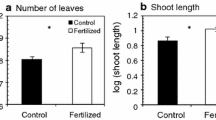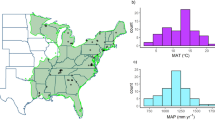Abstract.
N is often cited as a limiting factor for sapling growth in northeastern USA forests. However, under conditions of elevated soil N, seedlings and saplings of some tree species exhibit luxury consumption of N, leading to elevated tissue N concentration. While this pool of plant N may have benefits for saplings if light levels change, it may also increase the risk of herbivory by white-tailed deer (Odocoileus virginianus L.). We conducted a field fertilization experiment to test the hypothesis that saplings increase stem tissue N when soil N availability is elevated. We fertilized saplings of nine tree species under closed and open canopies. Two of the nine species, yellow birch (Betula alleghaniensis) and black cherry (Prunus serotina), had significant increases in radial growth when fertilized under high light. Six of the nine species showed increased stem N concentration under either low light or high light conditions. Under low light conditions, black cherry and sugar maple (Acer saccharum) had significantly higher concentrations of stem N when fertilized. Regardless of fertilization treatment, yellow birch had significantly greater stem N in saplings under low light conditions when compared with saplings found in high light conditions. Under high light conditions, fertilization resulted in increased stem N in saplings of white ash (Fraxinus americana) and eastern hemlock (Tsuga canadensis). There was a trend for saplings of red maple (Acer rubrum) and white ash to show elevated stem N concentration when fertilized under low light. Red oak (Quercus rubra), American beech (Fagus grandifolia) and white pine (Pinus strobus) did not show any evidence of luxury consumption. We compared browse frequency of fertilized and unfertilized saplings within similar forest types. Browse frequency was consistently higher on fertilized saplings. When averaged across all species, however, the difference between treatments was not significant. In contrast, we found significantly higher browse rates for fertilized saplings that had been previously identified as luxury N consumers. Our results indicate that increased soil N availability has positive effects on at least some of the species under high light, but, has potentially negative indirect effects on a larger group of species under both high and low light due to a higher risk of herbivory.
Similar content being viewed by others
Author information
Authors and Affiliations
Corresponding author
Additional information
Electronic Publication
Rights and permissions
About this article
Cite this article
Tripler, C., Canham, C., Inouye, R. et al. Soil nitrogen availability, plant luxury consumption, and herbivory by white-tailed deer. Oecologia 133, 517–524 (2002). https://doi.org/10.1007/s00442-002-1046-x
Received:
Accepted:
Published:
Issue Date:
DOI: https://doi.org/10.1007/s00442-002-1046-x




